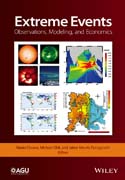
Extreme Events: Observations, Modeling, and Economics
Chavez, Mario
Ghil, Michael
Fucugauchi, Jaime Urrutia
The monograph covers the fundamentals and the consequences of extreme geophysical phenomena like asteroid impacts, climatic change, earthquakes, tsunamis, hurricanes, landslides, volcanic eruptions, flooding, and space weather. This monograph also addresses their associated, local and worldwide socio–economic impacts. The understanding and modeling of these phenomena is critical to the development of timely worldwide strategies for the prediction of natural and anthropogenic extreme events, in order to mitigate their adverse consequences. This monograph is unique in as much as it is dedicated to recent theoretical, numerical and empirical developments that aim to improve: (i) the understanding, modeling and prediction of extreme events in the geosciences, and, (ii) the quantitative evaluation of their economic consequences. The emphasis is on coupled, integrative assessment of the physical phenomena and their socio–economic impacts. With its overarching theme, Extreme Events: Observations, Modeling and Economics will be relevant to and become an important tool for researchers and practitioners in the fields of hazard and risk analysis in general, as well as to those with a special interest in climate change, atmospheric and oceanic sciences, seismo–tectonics, hydrology, and space weather. INDICE: Contributors .Foreword: Mario Chavez, Michael Ghil, Jaime Urrutia–Fucugauchi .Acknowledgments .1. Introduction .Mario Chavez, Michael Ghil, Jaime Urrutia–Fucugauchi .Part A. Fundamentals and Theory . 2. Applications of Extreme Value Theory to Environmental Data Analysis .Gwladys Toulemonde, Pierre Ribereau and Philippe Naveau .3. Dynamical Systems Approach to Extreme Events Catherine Nicolis and G. Nicolis .4. The Skill of Data Based Predictions Versus Dynamical Models – Case Study on Extreme . Temperature Anomalies .Stefan Siegert, Jochen Broecker, Holger Kantz .5. Detecting and Anticipating Climate Tipping Points Rates .Timothy M. Lenton and Valerie N. Livina .6. Understanding ENSO Variability and its Extrema: A Delay Differential Equation Approach .Michael Ghil and Ilya Zaliapin .Part B. Extreme Events in Earth s Space Environment .7. Drivers of Extreme Space Weather Events: Fast Coronal Mass Ejections .A. Ruzmaikin, J. Feynman, and S. Stoev .8. Chicxulub Asteroid Impact: An Extreme Event at the Cretaceous/Paleogene Boundary .Jaime Urrutia–Fucugauchi and Ligia Pérez–Cruz .Part C. Climate and Weather Extremes .9. Weather and Climatic Drivers of Extreme Flooding Events Over the Midwest of the United States .Andrew W. Robertson, Yochanan Kushnir, Upmanu Lall, and Jennifer Nakamura .10. Analysis of the Hazards and Vulnerability of the Cancun Beach System: The Case of Hurricane Wilma .Edgar Mendoza, Rodolfo Silva, Cecilia Enriquez–Ortiz, Ismael Mariño–Tapia and Angélica Felix .11. Observations and Modeling of Environmental and Human Damage Caused by the . 2004 Indian Ocean Tsunami . Kazuhisa Goto, Fumihiko Imamura, Shunichi Koshimura, Hideaki Yanagisawa .12. Extreme Capillary Wave Events Under Parametric Excitation . M. G. Shats, H. Xia, and H. Punzmann .Part D. Extreme Events in the Solid Earth .13. A Review of Great Magnitude Earthquakes and Associated Tsunamis along the Guerrero, Mexico . Pacific coast: a Multiproxy Approach . María–Teresa Ramírez–Herrera, Néstor Corona and Gerardo Suárez .14. Landslide Risk to the Population of Italy and its Geographical and Temporal Variations .Paola Salvati, Mauro Rossi, Cinzia Bianchi and Fausto Guzzetti .15. An Extreme Event Approach to Volcanic Hazard Assessment . Servando De la Cruz–Reyna and Ana Teresa Mendoza–Rosas .Part E. Socio–Economic Impacts of Extreme Events .16. Economic Impact of Extreme Events: An Approach Based on Extreme Value Theory . Richard W. Katz. .17. Extreme Magnitude Earthquakes and their Direct Economic Impacts, A Hybrid Approach . Mario Chavez, Eduardo Cabrera, Silvia Garcia, Erik Chavez, Mike Ashworth, Narciso Perea and Alejandro Salazar .18. Tropical Cyclones: From the Influence of Climate to their Socio–Economic Impacts .Suzana J. Camargo and Solomon M. Hsiang .19. Impacts of Natural Disasters on a Dynamic Economy .Andreas Groth, Patrice Dumas, Michael Ghil and Stephane Hallegatte .Part F. Prediction and Preparedness .20. Extreme Tsunami Events in the Mediterranean and its impact on the Algerian Coasts . L. Amir 1, W. Dudley, B. McAdoo and A Yelles .21. Famous Failures: A Natural History of Disasters .Heriberta Castaños, Anand Joshi, Cinna Lomnitz and Chao–jun Zhang .22. On Predictive Understanding of Extreme Events: Pattern Recognition Approach; Prediction Algorithms; Applications to Disaster Preparedness .Vladimir Keilis–Borok+, Alexandre Soloviev and Andrei Gabrielov .Index
- ISBN: 978-1-119-15701-4
- Editorial: John Wiley & Sons
- Encuadernacion: Cartoné
- Páginas: 462
- Fecha Publicación: 22/01/2016
- Nº Volúmenes: 1
- Idioma: Inglés
